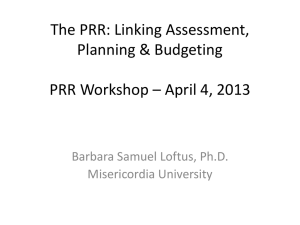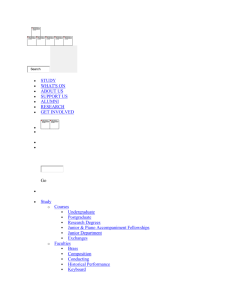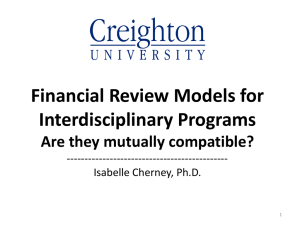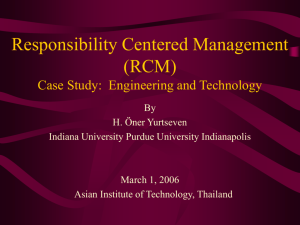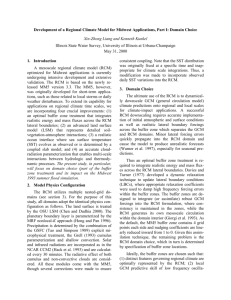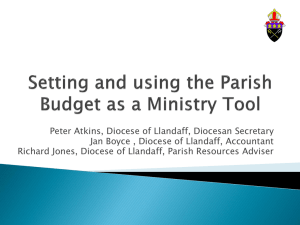ALL POLITICS IS LOCAL-MAKE YOURS COUNT
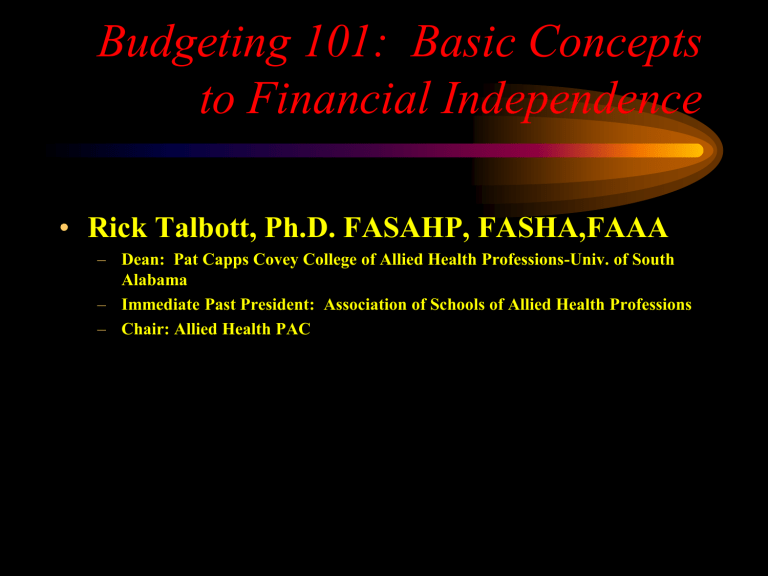
Budgeting 101: Basic Concepts to Financial Independence
• Rick Talbott, Ph.D. FASAHP, FASHA,FAAA
–
Dean: Pat Capps Covey College of Allied Health Professions-Univ. of South
Alabama
–
Immediate Past President: Association of Schools of Allied Health Professions
– Chair: Allied Health PAC
WHY WE NEED TO ARM
OURSELVES
• Quote for the Day: “ I don’t care what the question is---- the ANSWER is MONEY”
•
Somewhat cynical but information is power-- and most of your Departmental goals/problems cannot be solved without -getting more, keeping what you get, and avoiding fatal budgeting errors.
•
Transformational Leadership great but
Transactional Opens the Leadership Door
OVERVIEW OF
PRESENTATION
• Arming for Communication with CFO and Avoiding Jail Time
• Pragmatics of University Budget Process
• Budget Strategies and Difficulties Dean’s See from Departments
Budgeting
• Clinic Budgets– One Innovative Model
• Budgetary/Compliance Challenges in IPE Models
• Major Dos-Don’ts
•
Discussion: What are issues you face? Questions?
• IS TBL SESSION
Alphebet Soup of Accounting
•
GAAP– GENERALLY ACCEPTED ACCOUNTING
PRINCIPLES
•
GASB: GOVERNMENTAL ACCOUNTING
STANDARDS BOARD
•
AICPA: AMERICAN INSTITUTE OF CERTIFIED
PUBLC ACCOUNTANTS
–
Recognizes GASB as the designated body to establish accounting principles for state and local governments
Financial Accounting vs Cost
Accounting
1. Financial accounting aims at finding out results of accounting year in the form of Profit and Loss Account and
Balance Sheet.
2. Cost Accounting aims at computing cost of production/service in a scientific manner and facilitate cost control and cost reduction.
Most universities, public or private, provide the Chair with adequate Financial Accounting data. The challenge to the
Chair is what financial/cost information is critical for strategic planning.
The Vocabulary
•
Accrual Basis : the basis of accounting under which revenues are recorded when earned and expenditures (or expenses) are recorded as soon as they result in liabilities for benefits received, notwithstanding that the receipt of cash or the payment of cash may take place, in whole or in part, in another accounting period. Most universities or entities of any size use– if not any delays in payments would skew financial results on cash basis.
•
Cash Basis: The basis of accounting under which revenues are recorded when received in cash and expenditures (or expenses) are recorded when cash is disbursed.
•
Modified Accrual Basis and Modified Cash Basis – Just what you need –exceptions to the rules--
The Vocabulary Cont.
•
ZBB—Zero Based Budgeting: A budget based on the concept that the very existence of each activity must be justified each year, as well as the amounts of resources requested to be allocated to each activity. Impossible in pure sense in academics– unless eliminate tenure.
•
Incremental Budgeting– Most common in academics/non or not for profits. Uses last years expenditures as a base for estimates and justifies an increase (increment) above the base. Requires little analysis or review of goals—low brainer. ASHA, as example of NP, uses actuals from previous year as starting point and requires justifications for anything above– need very dedicated and ethical budget administrators
Vocabulary Cont
•
PPBS– Planning, Programming, Budgeting Systems:
Incorporates the concept of zero-base budgeting but PPBS is in effect an integration of a number of techniques in a planning and budgeting process for identifying, costing and assigning a complexity of resources for establishing priorities and strategies in a major program and for forecasting costs, expenditure and achievements within the immediate financial year or over a longer period. ZBB is usually restricted to year to year budgeting/planning while PPBS may involve a budget plan for multiple years.
–
Strategic planning absent consideration of budget implications/resources is a waste of time--- witness the recent changes in regional accreditation emphasis on the financial analysis– SACS
–
Professional Association Planning: combination of approaches but should always tie to the Strategic Map–
Major Budgeting Concerns in CSD
Programs
•
Major Budget Need: Personnel
•
Loss of Revenue from Legislature
•
Increasing Accountability/Compliance
•
Unfunded FTE Flexibility
•
Research Support Funding Reduction
•
The FTE Argument
•
The Changing Academic Environment-IPE
MANAGEMENT ACCOUNTING IN
THE ACADEMIC DEPARTMENT
– EFFICIENCY: Managers Do Things Right
– EFFECTIVENESS: Leaders Do The Right Things
–
Both NECESSARY but neither SUFFICIENT
– McGreggor Burns: No Change—No Leadership– Just
Management
– MANAGEMENT ACCOUNTING: Focuses on the Development,
Reporting, and Use of Accounting Information to Inform Strategic
Decisions and Verify the Efficacy Thereof
–
Efficient and accurate management will usually keep you out of jail but the opportunities for innovative curricular and clinical models requires leadership--
MOVING THE BALL—CHANGE
AGENTS IN YOUR SYSTEM
• CULTURE EATS STRATEGY FOR LUNCH
• THE VOCABULARY AND AT LEAST A MODICUM OF
ACCOUNTING/FINANCING EXPERIENCE NEEDED BUT
CRITICAL TO SUCCESS IS THOROUGH UNDERSTANDING OF
THE FINANCIAL CULTURE OF YOUR INSTITUTION.
• MAKING THE ARGUMENT:
–
DRIVER IS CH NOT BIS IN MOST INSTITUTIONS
–
FTE ANALYSIS– SCH; FTE; OVERHEAD; INDIRECT RETURNS;
–
CLINIC BUDGET RETURNS–
•
The conundrum: Keep it all: Pay for it all
• Tipping Point: Compute Clinic FTE needed to cover accreditation requirements based on college/university enrollment goals.
Budget Planning Strategies
• Departments/Colleges/Universities will never have resources to do everything they are asked to do.
– $ Flow from states moved from state supported to state augmented
–
Goal from College or Department is to be the least dependent possible on system $s
•
Strategic Planning without accompanying Budget Planning may be intellectually stimulating but is not usually fruitful
• Many Extant Models– Typical
–
Implementation of comprehensive strategic and operational budget planning program
–
Examination of desired balance of tenured, non-tenure track professorial, instructional, adjunct
•
CAUTION: New Federal regulations (ACA) pertaining to part time faculty and Health Insurance coverage (<30 hrs/wk)
–
Program Review—Evaluation
–
Flexibility in Use of Resources
Data Driven Persuasion
•
Behind the Power Curve if You have Not
Reviewed National Comparable Data
•
: Argument Hierarchy
–
Accreditation Requirement– Careful
– Peer Institution Comparisons—
–
Multiple Data Sources– ASAHP IPS
ASAHP Institutional Profile
Survey Example
•
Can estimate efficiencies of own program with simple analysis (sample size caution)
•
Can calculate from the IPS Data
–
: Average operating Budget for the program in question
– Average FTE Enrollment for the program in question
– Average FTE Faculty reported for the program in question
DEAN’S OBSERVATIONS
REGARDING BUDGET MISSTEPS
• SPENDING REQUESTS NOT IN ORIGINAL GRANT BUDGET
•
MORE ALARMING IS SPENDING NOT IN ORIGINAL
–
Alert Staff
– Can’t depend on upstream protection
• “SOME CHAIRS KNOW WHERE EVERY PENNY IS—OTHERS SPEND
UNTIL DEAN’S OFFICE HAS TO BAIL OUT”
–
This would be a short term Chair in most institutions.
•
LACK OF PRIORITIZING ON PART OF CHAIR—WANT DEAN TO DO
THEIR JOB.
• BUDGETING NOT TIED TO UNIVERSITY, COLLEGE STRATEGIC
PLANS
– RECENT CHANGES IN REGIONAL ACCREDITATION REQUIREMENTS
•
FAILURE TO UNDERGIRD BUDGET ARGUMENTS WITH
NATIONAL/REGIONAL EMPLOYMENT—FUTURE NEED DATA
DEAN’S COMMENTS CON’T
• LACK OF CONTINGENCY PLANNING FOR STATE
APPROPRAITION CUTS
– SHOULD HAVE % CUT RELATED PLAN
– MINDLESS ACROSS THE BOARD CUTS NOT ATYPICAL
–
DISCUSSION WITH NEXT LEVEL OF ADMINISTRATION
BEFORE CUTS COME—MAYBE EVEN BEFORE
ACCEPTING THE POSITION
•
UNFUNDED RESEARCH FTE
–
How much is/should be funded by institution
– As many approaches as are institutions – again, culture critical
• PHILOSOPHICAL CHALLENGE:
• WOUND ALL vs CUT ONE
Responsibility Center
Manbagement (RCM)
•
Reduction in state funding leading universities to rethink their business models in order to stay afloat.
•
RCM is one such model and from turn of century to now approximately 15%-20%
(depending on type of institution) of universities have adopted RCM model
• First introduced in 70’s/80’s
REFERENCE FOR
DISCUSSION
•
Following discussion source mainly from the 2013 Responsibility Center
Managmemnt text by John Curry, Andrew
Laws, Jon Strauss: Responsibility Center
Management- A Guide to Balancing
Academic Entrepreneurship with Ficcal
Responsibility-- NACUBO
RCM Basics
• RCM is an example of the broader category incentive based budgeting models.
•
Tuition and research revenues are allocated to the colleges and schools (the responsibity centers)
• On the other side of the ledger facilities and central administration costs are also prorated to the colleges and schools.
•
A subvention pool (centralized $ bucket) is maintained by central administration for balancing individual disciplines cost/price differentials and that support/reflect university priorities.
• Historically, faculty are empowered to make decisions concerning the space utilization, enrollment, curriculum, syllabi, etc. All of these decisions have financial consequences (impact enrollment which affects tuition which is major bottom line driver).
• Interesting that accreditation standards are requiring closer ties to university academic policies/priorities and the budget process.
Goals of RCM
• Linking the responsibility for financial management with the decision authority in universities.
•
Clarifying by specific allocation and specification of the fiscal responsibility to central or decentralized management.
12 Year Report: Curry, Laws, Srauss -
Responsibility Center Management
NACUBO, 2013
– 1. LEADERSHIP COMMITMENT/INVOLMENT
SIGNIFICANTLY INCREASED
: Skill sets for Chair, Deans, VPs different
: Not all up to task but involvement greatly increased in RCM
: Warren Bennis’s Quote ( Bennis is University Professor and
Distinguished Professor of Business Administration and Founding Chairman of The
Leadership Institute at the University of Southern California)
“You need strong leaders to do the right things: you need strong managers to do things right ”
: Report indicates that RCM ctrs benefit from more engaged leadership—those who have retreated from full RCM implementation can be traced to leadership discomfort with the “constructive tension, financial management expectations, and transparency inherent in RCM”
2. RCM Enhances Commitment to long-term planning
• Long term focus was consistently reported to be increased at the department/school level.
• Retention of surpluses to enable future years startups cited
•
Future facilities financing, planning
• Goal: ensure future years’ gudgets can cover debt service/maintenance costs
3. Enrollment Incentives Work
•
Participants indicated allocating enrollment revenues to centers improves their responosiveness to course needs and opportunities
–
USA examples: Professional Fees/Salary
“Academic units appear to pay much better attention to course and program design in order to maximize their revenue return”
4. Research Incentives Work
•
Indirect cost return policy that is explicitly articulated to differentiate instruction and research and compare with indirect cost recoveries, can analyze costs incurred with costs recovered.
–
Area needs refinement—sharpen pencil on indirects-costs are underestimated by faculty
5 . Quality and strategic assessments are mediated by bottom lines
•
Move from previous analysis of benefit to analysis of benefit at what cost.
•
Example: Is school or program worth the investment of resources relative to its quality and strategic priority. How can it be more self supporting. In clinical world are many opportunities.
6. Reliance on data has increased data quality.
•
Obvious increase in the validity of the information one is using when it affects the actual bottom line of the unit rather than just fulfilling some institutional reporting requirement.
RCM SUMMARY THOUGHTS
• LIKE MOST THINIGS: DEPENDS ON ENLIGHTENED/INFORMED
LEADERSHIP SKILLS-THROUGHOUT
• ROLE AND RELATIONSHIP OF CHAIRS, DEANS, PROVOSTS TO THE
CFO MUST CHANGE TO BE MORE DIRECT AND COLLABORATIVE
• The Promise: “Clarifying roles and responsibilities between local and central units, coupling academic authority with financial responsibility, linking cause and effect through revenue and indirect cost allocations, and incentivizing resource development and financial accountability.”
• For success: “Requires never-ending vigilance to assure that the fundamental incentives are not being subverted, and a major commitment from institutional leaders to work within and appropriately adapt the system.”
FILLING THE BUCKET
•
SEMI DISCRETIONARY SOURCES
–
Foundations
–
Research Grants
–
Development Initiatives
• Patients
• Parents
• Faculty– Legacy Funding
•
CLINIC INCOME
CLINICAL INCOME
–
In House Models
•
Essential but often not profitable
•
Hard funding amounts often the key
–
PRN—Consultation Contracts
–
Internal ORL Clinic Model
OVERVIEW OF ORL/CSD
MODEL
•
OPPORTUNITY CIRCUMSTANCE
•
FUNCTION-- IPE to IPP
•
FOUR YEARS – STILL TWEEKING
•
BENEFITS
– FINANCIAL
–
EDUCATIONAL
– INSPRIATIONAL
Organization of Model
WHAT SUPPORT IS NEEDED
WITHOUT A COMPARABLE HSF WOULD BE
DIFFICULT-BUT DOABLE
SIMPLE THOUGHT – NOT SO SIMPLE
EXECUTION-ENCOUNTERS
PERSONNEL MGT
ALTERNATIVES
COMPLIANCE ISSUES--
AVOIDING JAIL TIME
PQRS—Physician Quality
Reportiing System
HIPAA
NOT YET BUT COMING
QUALITY MONITORING
FUNCTIONS
TRAINING FUNCTIONS
GENERAL ADMINISTRATIVE
HSF/Clinic Staff Administrative
Functions
ADMIN FUNCTIONS
CONTINUED
COMPUTER SOFTWARE
SUPPORT
SUMMARY AND DISCUSSION
•
GIVING AWAY SERVICES IS NOT THE MODEL TO
IMPRINT FOR OUR STUDENTS
•
SOUND BUDGETARY/FISCAL ADMINISTRATION IS
A PART OF THE CHAIRS RESPONSIBILITY
•
MOVING TO 10-20% STATE SUPPORT WILL
REQUIRE A MORE PRIVATE UNIVERSITY
APPROACH
• BUDGET CHALLENGES FOR DISCUSSION

